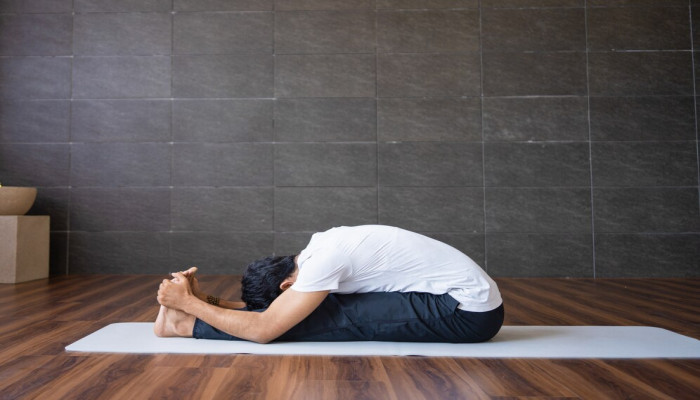 Launch apps instantly. Claim $200 credits on DigitalOcean
Launch apps instantly. Claim $200 credits on DigitalOcean
7 yoga poses to help overcome depression
Written by aadhira gopal » Updated on: March 12th, 2024

In today's fast-paced world, mental health has taken center stage in discussions about well-being. Depression, a common but serious mood disorder, affects millions globally, influencing their ability to feel, think, and handle daily activities. Among the myriad of therapeutic strategies to combat depression, yoga stands out as a powerful tool to ease the mind and uplift spirits. Interestingly, integrating yoga into your life can also transform mundane moments into celebrations of well-being, much like a birthday celebration marks a new beginning or milestone.
1. Balasana (Child’s Pose)
Balasana, often referred to as Child’s Pose, provides a gentle retreat from the chaos of daily life. As you fold forward and surrender your body to the earth, you create a safe and nurturing space for introspection and release. This pose gently stretches the back, hips, and thighs, relieving tension and promoting relaxation. By focusing on the breath and allowing yourself to let go, Balasana offers a profound sense of peace and calm, making it an excellent choice for those seeking relief from the symptoms of depression.
2. Setu Bandhasana (Bridge Pose)
Setu Bandhasana, or Bridge Pose, is a heart-opening posture that encourages feelings of openness and vulnerability. As you lift your hips towards the sky, you create space in the chest and throat, facilitating deep, expansive breaths. This pose helps to counteract the physical manifestations of depression, such as hunched posture and shallow breathing. By cultivating a sense of lightness and buoyancy, Setu Bandhasana fosters a more positive outlook on life, helping individuals to overcome feelings of sadness and lethargy.
3. Uttanasana (Standing Forward Bend)
Uttanasana, or Standing Forward Bend, offers a moment of surrender and release as you fold forward and let gravity take hold. This pose gently stretches the entire back body, releasing tension in the spine, shoulders, and neck. The act of folding inward encourages introspection and self-compassion, providing an opportunity to connect with your inner world. Uttanasana teaches us to let go of what no longer serves us, making it a valuable tool for managing the symptoms of depression and anxiety.
4. Adho Mukha Svanasana (Downward-Facing Dog)
Adho Mukha Svanasana, commonly known as Downward-Facing Dog, is an energizing posture that strengthens the entire body while promoting a sense of grounding and stability. This pose improves circulation, sending fresh blood flow to the brain and lifting your mood. As you press your palms into the earth and lift your hips towards the sky, you create space in the spine and chest, fostering feelings of openness and expansion. Downward-Facing Dog is a powerful antidote to feelings of lethargy and inertia, helping you to feel more alert, awake, and alive.
5. Urdhva Mukha Svanasana (Upward-Facing Dog)
Urdhva Mukha Svanasana, or Upward-Facing Dog, is a heart-opening pose that encourages feelings of confidence and empowerment. As you lift your chest and gaze towards the sky, you open yourself up to new possibilities and opportunities. This pose strengthens the back muscles and improves posture, counteracting the slouched posture often associated with depression. By cultivating a sense of courage and resilience, Upward-Facing Dog helps individuals to overcome feelings of self-doubt and negativity, empowering them to embrace life with renewed enthusiasm.
6. Savasana (Corpse Pose)
Savasana, also known as Corpse Pose, is a deeply relaxing posture that promotes physical, mental, and emotional relaxation. As you lie flat on your back, allowing your body to sink into the earth, you release tension and stress from every muscle. This pose provides an opportunity to surrender control and simply be present in the moment, free from worry or distraction. Savasana is a powerful tool for managing the symptoms of depression, offering a sense of peace and calm amidst life's challenges. By practicing Savasana regularly, individuals can cultivate a greater sense of inner peace and resilience, enabling them to navigate difficult emotions with grace and ease.
7. Anulom Vilom Pranayama (Alternate Nostril Breathing)
While not a pose, Anulom Vilom Pranayama, or Alternate Nostril Breathing, is a yogic breathing technique that can significantly aid in overcoming depression. This practice helps to balance the left and right hemispheres of the brain, promoting emotional and psychological balance. Through controlled breathing, individuals can calm the mind, reduce stress, and enhance their mood, making it an essential practice for mental wellness.
8. Viparita Karani (Legs-Up-the-Wall Pose)
Viparita Karani, also known as Legs-Up-the-Wall Pose, involves lying on your back with your legs extended vertically against a wall. This gentle inversion allows blood to flow from the legs back to the heart, promoting circulation and relaxation. By alleviating pressure on the legs and lower back, Viparita Karani can provide relief from physical tension and mental stress. Practicing this pose regularly can help calm the nervous system, reduce anxiety, and improve overall well-being. It's a simple yet effective way to create a sense of grounding and balance, making it particularly beneficial for individuals struggling with depression or feelings of overwhelm.
9. Bhujangasana (Cobra Pose)
Bhujangasana, also known as Cobra Pose, involves lying on your stomach and lifting your chest off the ground while keeping your lower body grounded. This backbend stretches the front of the body, including the chest, lungs, and shoulders, while also strengthening the spine and stimulating the abdominal organs. As you lift your heart towards the sky in Bhujangasana, you may experience an increase in energy and mood. This pose is often recommended for those dealing with depression as it opens the heart center, fostering feelings of positivity and self-confidence. Regular practice of Cobra Pose can help uplift your spirits and promote emotional well-being.
10. Matsyasana (Fish Pose)
Matsyasana, or Fish Pose, is a gentle backbend that opens the chest, throat, and heart center. To practice Matsyasana, lie on your back and lift your chest towards the sky while keeping your head and shoulders grounded. This pose stretches the muscles of the chest and abdomen, while also stimulating the thyroid gland and improving circulation. By opening the heart center, Matsyasana can help release emotional tension and promote feelings of joy and well-being. It's often used as a therapeutic posture for individuals struggling with depression, anxiety, or low self-esteem. Practicing Fish Pose regularly can help you connect with your inner strength and resilience, allowing you to navigate life's challenges with greater ease and grace.
Conclusion: Embracing Yoga for Mental Wellness
Yoga offers a holistic approach to combating depression, emphasizing the connection between mind, body, and spirit. Through these seven poses, individuals can find solace, strength, and rejuvenation, paving the way for healing and happiness. Just as a breakout escape rooms marks a new chapter of life, incorporating yoga into your daily routine can signify a fresh start in your mental health journey. By acknowledging the power of yoga to transform our mental state, we can step into a more balanced, joyful, and resilient version of ourselves, ready \face life's challenges with a renewed sense of hope.
Copyright © 2024 IndiBlogHub.com Hosted on Digital Ocean









Post a Comment
To leave a comment, please Login or Register